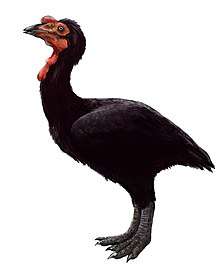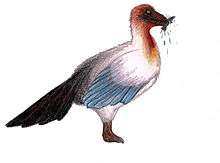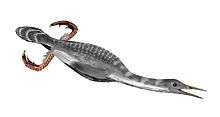Troodon
Troodon (/ˈtroʊ.ədɒn/ TROH-ə-don; Troödon in older sources) is a former wastebasket taxon and a potentially dubious genus of relatively small, bird-like dinosaurs known definitively from the Campanian age of the Cretaceous period (about 77 mya). It includes at least one species, Troodon formosus, known from Montana. Discovered in October 1855, T. formosus was among the first dinosaurs found in North America, although it was thought to be a lizard until 1877. Several well-known troodontid specimens from the Dinosaur Park Formation in Alberta were once believed to be members of this genus. However, recent analyses in 2017 have found the genus to be undiagnostic and referred some of these specimens to the genus Stenonychosaurus (long believed to be synonymous with Troodon) and others to the newly created genus Latenivenatrix.
| Troodon | |
|---|---|
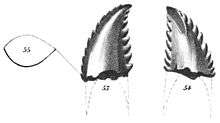 | |
| Illustration of the T. formosus holotype tooth | |
| Scientific classification | |
| Kingdom: | Animalia |
| Phylum: | Chordata |
| Clade: | Dinosauria |
| Clade: | Saurischia |
| Clade: | Theropoda |
| Family: | †Troodontidae |
| Subfamily: | †Troodontinae Gilmore, 1924 |
| Genus: | †Troodon Leidy, 1856 |
| Type species | |
| †Troodon formosus Leidy, 1856 | |
The genus name is Greek for "wounding tooth", referring to the teeth, which were different from those of most other theropods known at the time of their discovery. The teeth bear prominent, apically oriented serrations. These "wounding" serrations, however, are morphometrically more similar to those of herbivorous reptiles, and suggest a possibly omnivorous diet.[1]
History of discovery
Early research
The name was originally spelled Troödon (with a diaeresis) by Joseph Leidy in 1856, which was officially amended to its current status by Sauvage in 1876.[2] The type specimen of Troodon has caused problems with classification, as the entire genus is based only on a single tooth from the Judith River Formation. Troodon has historically been a highly unstable classification and has been the subject of numerous conflicting synonymies with similar theropod specimens.[3]
The Troodon tooth was originally classified as a "lacertilian" (lizard) by Leidy, but reassigned as a megalosaurid dinosaur by Nopcsa in 1901 (Megalosauridae having historically been a wastebin taxon for most carnivorous dinosaurs). In 1924, Gilmore suggested that the tooth belonged to the herbivorous pachycephalosaur Stegoceras, and that Stegoceras was in fact a junior synonym of Troodon (the similarity of troodontid teeth to those of herbivorous dinosaurs continues to lead many paleontologists to believe that these animals were omnivores). The classification of Troodon as a pachycephalosaur was followed for many years, during which the family Pachycephalosauridae was known as Troodontidae. In 1945, Charles Mortram Sternberg rejected the possibility that Troodon was a pachycephalosaur due to its stronger similarity to the teeth of other carnivorous dinosaurs. With Troodon now classified as a theropod, the family Troodontidae could no longer be used for the dome-headed dinosaurs, so Sternberg named a new family for them, Pachycephalosauridae.[4]
Naming of related species

The first specimens assigned to Troodon that were not teeth were both found by Sternberg in the early 1930s, in the Dinosaur Park Formation of Alberta. The first was named Stenonychosaurus inequalis by Sternberg in 1932, based on a foot, fragments of a hand, and some tail vertebrae. A remarkable feature of these remains was the enlarged claw on the second toe, which is now recognized as characteristic of early paravians. Sternberg initially classified Stenonychosaurus as a member of the family Coeluridae. The second, a partial lower jaw bone, was described by Gilmore (1932) as a new species of lizard which he named Polyodontosaurus grandis. Later, in 1951, Sternberg recognized P. grandis as a possible synonym of Troodon, and speculated that since Stenonychosaurus had a "very peculiar pes" and Troodon "equally unusual teeth", they may be closely related. Unfortunately, no comparable specimens were available at that time to test the idea. In a recent revision of the material by van der Reest & Currie, Polyodontosaurus was determined to be a nomen dubium, not fit for synonymy with other taxa.[5]
A more complete skeleton of Stenonychosaurus was described by Dale Russell in 1969 from the Dinosaur Park Formation, which eventually formed the scientific foundation for a famous life-sized sculpture of Stenonychosaurus accompanied by its fictional, humanoid descendant, the "dinosauroid".[6] Stenonychosaurus became a well-known theropod in the 1980s, when the feet and braincase were described in more detail. Along with Saurornithoides, it formed the family Saurornithoididae. Based on differences in tooth structure, and the extremely fragmentary nature of the original Troodon formosus specimens, saurornithoidids were thought to be close relatives while Troodon was considered a dubious possible relative of the family. Phil Currie, reviewing the pertinent specimens in 1987, showed that supposed differences in tooth and jaw structure among troodontids and saurornithoidids were based on age and position of the tooth in the jaw, rather than a difference in species. He reclassified Stenonychosaurus inequalis as well as Polyodontosaurus grandis and Pectinodon bakkeri as junior synonyms of Troodon formosus. Currie also made Saurornithoididae a junior synonym of Troodontidae.[7] In 1988, Gregory S. Paul went farther and included Saurornithoides mongoliensis in the genus Troodon as T. mongoliensis,[8] but this reclassification, along with many other unilateral synonymizations of well known genera, was not adopted by other researchers. Currie's classification of all North American troodontid material in the single species Troodon formosus became widely adopted by other paleontologists, and all of the specimens once called Stenonychosaurus were referred to as Troodon in the scientific literature through the early 21st century.
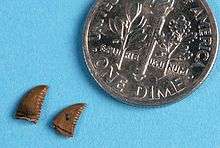
Dissolution of the one species model
However, the concept that all Late Cretaceous North American troodontids belong to one species began to be questioned soon after Currie's 1987 paper was published, including by Currie himself. Currie and colleagues (1990) noted that, while they believed the Judith River troodontids were all T. formosus, troodontid fossils from other formations, such as the Hell Creek Formation and Lance Formation, might belong to different species. In 1991, George Olshevsky assigned the Lance formation fossils, which had first been named Pectinodon bakkeri but later synonymized with Troodon formosus to the species Troodon bakkeri, and several other researchers (including Currie) have reverted to keeping the Dinosaur Park Formation fossils separate as Troodon inequalis (now Stenonychosaurus inequalis).[9]
In 2011, Zanno and colleagues reviewed the convoluted history of troodontid classification in Late Cretaceous North America. They followed Longrich (2008) in treating Pectinodon bakkeri as a valid genus, and noted that it is likely the numerous Late Cretaceous specimens currently assigned to Troodon formosus almost certainly represent numerous new genera, but that a more thorough review of the specimens is required. Because the holotype of T. formosus is a single tooth, this renders Troodon a nomen dubium.[3]
In 2017, Evans and colleagues further discussed the undiagnostic nature of the holotype of Troodon formosus and suggested that Stenonychosaurus be used for troodontid skeletal material from the Dinosaur Park Formation.[10] Later in the same year, Aaron J. van der Reest and Currie came to a similar conclusion as Evans and colleagues, and also split much of the material assigned to Stenonychosaurus into a new genus: Latenivenatrix.[5] In 2018, Varricchio and colleagues disagreed with Evans and colleagues, citing that Stenonychosaurus had not been used in the thirty years since Currie and colleagues synonymized it with Troodon, and they indicated that "Troodon formosus remains the proper name for this taxon".[11]
Classification
Troodon is considered to be one of the most derived members of its family. Along with Zanabazar, Saurornithoides and Talos it forms a clade of specialized troodontids.[3]
Below is a cladogram of Troodontidae by Zanno et al. in 2011.[3]
| Troodontidae |
| ||||||||||||||||||||||||||||||||||||||||||||||||||||||||||||||||||
Paleobiology
.jpg)
One study was based on multiple Troodon teeth that have been collected from Late Cretaceous deposits from northern Alaska. These teeth are much larger than those collected from more southern sites, providing evidence that northern Alaskan populations of Troodon grew to larger average body size, hinting at Bergmann's Rule. This study also provides an analysis of the proportions and wear patterns of a large sample of Troodon teeth. It proposes that the wear patterns of all Troodon teeth suggest a diet of soft foods - inconsistent with bone chewing, invertebrate exoskeletons, or tough plant items. This study hypothesizes a diet primarily consisting of meat.[12]
Paleoecology
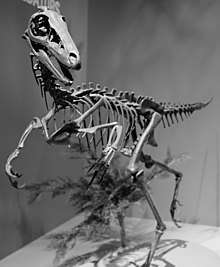
The type specimen of Troodon formosus was found in the Judith River Formation of Montana. The rocks of the Judith River Formation are equivalent in age with the Oldman Formation of Alberta,[13] which has been dated to between 77.5 and 76.5 million years ago.[14]
In the past, remains have been attributed to the same genus as the Judith River Troodon from a wide variety of other geological formations. It is now recognized as unlikely that all of these fossils, which come from localities hundreds or thousands of miles apart, separated by millions of years of time, represent a single species or genus of troodontid dinosaurs. Further study and more fossils are needed to determine how many species of Troodon existed. It is questionable that, after further study, any additional species can be referred to Troodon, in which case the genus would be considered a nomen dubium.[3]
Additional specimens currently referred to Troodon come from the upper Two Medicine Formation of Montana and the Prince Creek Formation of Alaska. There is some evidence that Troodon favored cooler climates, as its species seem to have been particularly abundant in northern and even Arctic areas and during cooler intervals, such as the early Maastrichtian.[15] Troodon-like teeth have been found in the lower Javelina Formation of Texas and the Naashoibito Member of the Ojo Alamo Formation in New Mexico.[16][17]
See also
References
- Holtz, Thomas R., Brinkman, Daniel L., Chandler, Chistine L. (1998) Denticle Morphometrics and a Possibly Omnivorous Feeding Habit for the Theropod Dinosaur Troodon. Gaia number 15. December 1998. pp. 159-166.
- H.-E. Sauvage, 1876, "Notes sur les reptiles fossiles", Bulletin de la Société Géologique de France, 3e série 4: 435-444
- Lindsay E. Zanno, David J. Varricchio, Patrick M. O'Connor, Alan L. Titus and Michael J. Knell (2011). Lalueza-Fox, Carles (ed.). "A new troodontid theropod, Talos sampsoni gen. et sp. nov., from the Upper Cretaceous Western Interior Basin of North America". PLoS ONE. 6 (9): e24487. Bibcode:2011PLoSO...624487Z. doi:10.1371/journal.pone.0024487. PMC 3176273. PMID 21949721.CS1 maint: multiple names: authors list (link)
- Sternberg, C. (1945). "Pachycephalosauridae proposed for domeheaded dinosaurs, Stegoceras lambei n. sp., described". Journal of Paleontology. 19: 534–538.
- van der Reest, A. J.; Currie, P. J. (2017). "Troodontids (Theropoda) from the Dinosaur Park Formation, Alberta, with a description of a unique new taxon: implications for deinonychosaur diversity in North America" (PDF). Canadian Journal of Earth Sciences. 54 (9): 919–935. Bibcode:2017CaJES..54..919V. doi:10.1139/cjes-2017-0031. hdl:1807/78296.
- Russell, D. A.; Séguin, R. (1982). "Reconstruction of the small Cretaceous theropod Stenonychosaurus inequalis and a hypothetical dinosauroid". Syllogeus. 37: 1–43.
- Currie, P. (1987). "Theropods of the Judith River Formation". Occasional Paper of the Tyrrell Museum of Palaeontology. 3: 52–60.
- Paul, G.S. (1988). Predatory Dinosaurs of the World. New York: Simon and Schuster. pp. 398–399. ISBN 978-0-671-61946-6.
- Currie, P. (2005). "Theropods, including birds." in Currie and Koppelhus (eds). Dinosaur Provincial Park, a spectacular ecosystem revealed, Part Two, Flora and Fauna from the park. Indiana University Press, Bloomington. Pp 367–397.
- Evans, D. C.; Cullen, T.M.; Larson, D.W.; Rego, A. (2017). "A new species of troodontid theropod (Dinosauria: Maniraptora) from the Horseshoe Canyon Formation (Maastrichtian) of Alberta, Canada". Canadian Journal of Earth Sciences. 54 (8): 813–826. Bibcode:2017CaJES..54..813E. doi:10.1139/cjes-2017-0034.
- Varricchio, D. J.; Kundrát, M.; Hogan, J. (2018). "An Intermediate Incubation Period and Primitive Brooding in a Theropod Dinosaur". Scientific Reports. 8 (1): 12454. doi:10.1038/s41598-018-30085-6. PMC 6102251. PMID 30127534.
- Fiorillo, Anthony R. (2008) "On the Occurrence of Exceptionally Large Teeth of Troodon (Dinosauria: Saurischia) from the Late Cretaceous of Northern Alaska" Palaios volume 23 pp.322-328
- Eberth, David A. (1997). "Judith River Wedge". In Currie, Philip J.; Padian, Kevin (eds.). Encyclopedia of Dinosaurs. San Diego: Academic Press. pp. 199–204. ISBN 978-0-12-226810-6.
- Arbour, V.M.; Burns, M. E.; Sissons, R. L. (2009). "A redescription of the ankylosaurid dinosaur Dyoplosaurus acutosquameus Parks, 1924 (Ornithischia: Ankylosauria) and a revision of the genus". Journal of Vertebrate Paleontology. 29 (4): 1117–1135. doi:10.1671/039.029.0405.
- Fiorillo, Anthony R.; Gangloff, Roland A. (2000). "Theropod teeth from the Prince Creek Formation (Cretaceous) of Northern Alaska, with speculations on Arctic dinosaur paleoecology". Journal of Vertebrate Paleontology. 20 (4): 675–682. doi:10.1671/0272-4634(2000)020[0675:TTFTPC]2.0.CO;2.
- Langston, Standhardt and Stevens, (1989). "Fossil vertebrate collecting in the Big Bend - History and retrospective." in Vertebrate Paleontology, Biostratigraphy and Depositional Environments, Latest Cretaceous and Tertiary, Big Bend Area, Texas. Guidebook Field Trip Numbers 1 a, B, and 49th Annual Meeting of the Society of Vertebrate Paleontology, Austin, Texas, 29 October - 1 November 1989. 11-21.
- Weil and Williamson, (2000). "Diverse Maastrichtian terrestrial vertebrate fauna of the Naashoibito Member, Kirtland Formation (San Juan Basin, New Mexico) confirms "Lancian" faunal heterogeneity in western North America." Geological Society of America Abstracts with Programs, 32: A-498.
- Russell, D. A. (1987). "Models and paintings of North American dinosaurs." In: Czerkas, S. J. & Olson, E. C. (eds) Dinosaurs Past and Present, Volume I. Natural History Museum of Los Angeles County/University of Washington Press (Seattle and Washington), pp. 114–131.
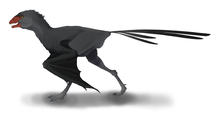
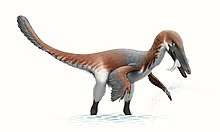
.png)
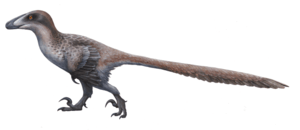

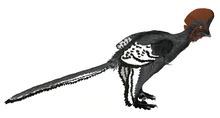
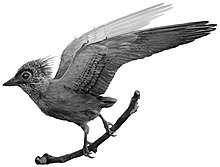

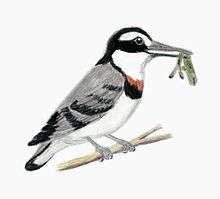
.png)
